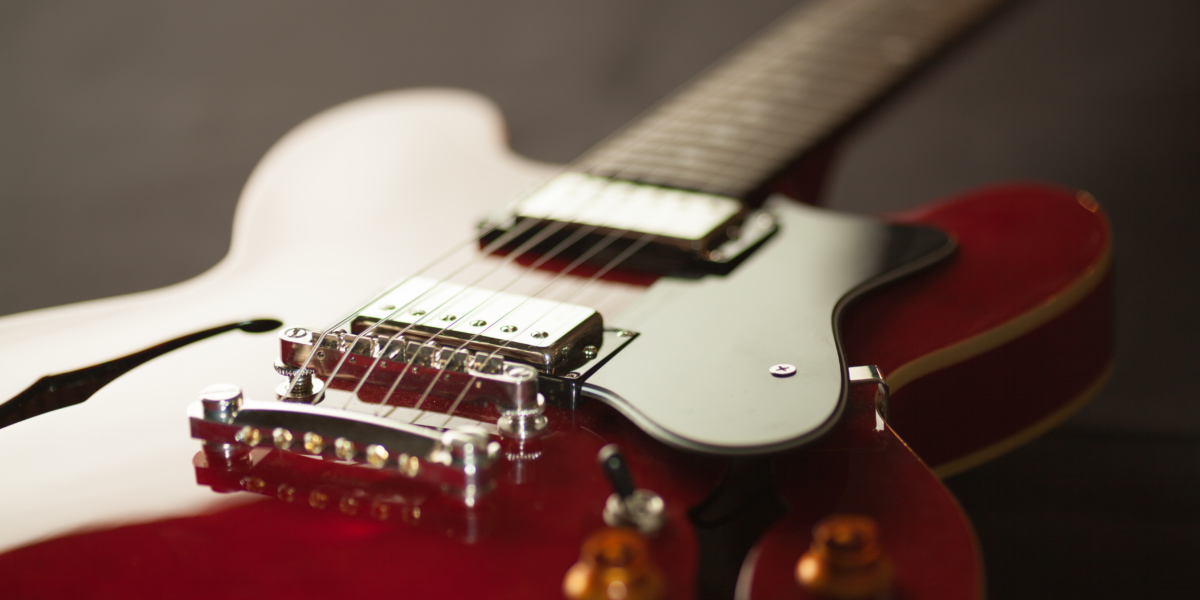How To Tune An Electric Guitar With And Without A Tuner

This article teaches you how to tune your electric guitar with and without a tuner.
Tuning your instrument is an essential part of being a guitarist.
An untuned guitar has a dramatic impact on the music you create.
It affects synchronicity in a band.
It makes you sound off (to put it lightly).
There are many ways to tune an electric guitar, which usually only takes a few minutes.
As a beginner, you may be unsure about tuning your instrument.
That’s why we put together this guide.
It helps you understand tuning and explains a few methods to tune your electric guitar.
The essentials of guitar tuning.
Tuning your guitar means assigning a particular pitch to the open strings of your instrument.
There are many tunings.
Drop D, Open G, Open D, and GABDEG, to name a few.
People use them for playing particular genres.
For instance, many guitarists tune their instrument to ‘Drop C’ when playing metal!
As a beginner, you don’t need to worry about the different types of tunings for now.
The standard tuning (the one we are focusing on) for a guitar is E-A-D-G-B-E.

Tuning pegs
There are six tuning pegs on the guitar’s headstock.
By turning them, you tighten and loosen the strings of your electric guitar.
When your instrument is out of tune, a string is either too tight and sharp (#), or too loose and flat (♭).
The tuning pegs allow you to tighten or lengthen the strings to change the pitch of your guitar.
How to tune an electric guitar with a tuner.
There are tons of effective, affordable, and easy-to-use tuning devices available.

We cover the different guitar tuners and how to use them in our blog post, How to Use a Guitar Tuner Step-by-Step.
Regardless of the tuner, you have, tuning your electric guitar is the same.
Guitar tuners gauge your instrument’s pitch in sound or vibration.
By playing an open string, the tuner interprets the pitch and shows you if you’re off and by how much.
To tune your electric guitar, find a quiet room and follow these steps:
- Open your tuner and set it to the desired settings (i.e., standard tuning E-A-D-G-B-E).
- Grab your guitar and plug it into your amp (make sure any modulations are off).
- Play the open E chord and tighten or loosen the string as indicated on the tuner.
- Repeat the process for each string.
Just like that, you’re ready to play!
How to tune an electric guitar without a tuner.
There are a few ways to tune your guitar without a tuner. However, they require experience and a deeper, more intimate understanding of the correct pitch.
Tune by ear
Many guitarists know how to tune their instruments just by listening.
It takes time. However, as you familiarize yourself with the sound of an in-tune guitar, making corrective adjustments becomes intuitive.
When tuning your electric guitar by ear, the process is the same as a tuner.
You play an open string and tighten or loosen it as needed.
To ensure that you’re doing it correctly, check with a tuner.
Eventually, you can tune your guitar confidently without the assistance of a tuning device.
Tune with a piano
You can always tune your guitar using a piano (assuming the piano is in tune).
In the end, pitch is pitch.
You can tune your guitar strings by comparing the sound of your guitar strings to the piano’s keys.
We get into the nitty-gritty on how to do that in our blog, How to Tune a Guitar With a Piano.
Relative tuning
Another tuning technique is known as ‘relative tuning.’ This is the process of using one string to tune the next.
The sixth (low E) string must be in the correct pitch.
It serves as the reference point for tuning the rest of the strings.
By holding the fifth fret down, you know what the following lower string needs to sound like.
Follow these steps to apply the relative tuning technique:
- Play the sixth string at the fifth fret and adjust the open fifth string (A string) so it sounds the same.
- Repeat the process for the next two strings (fourth and third).
- When tuning the second string, play the fourth fret on the third string as the reference point for the correct pitch.
- Use the fifth fret on the second string for the first and final strings.
If this process is still unclear, check out this YouTube video that walks you through it.
How often should you tune your electric guitar?
Now that you know some tuning techniques, it’s good to know how often you should tune your instrument.
Many variables affect the pitch of your strings.
It depends on the frequency and intensity that you play.
The strings you use and your guitar itself affect how quickly they get out of tune.
And even when you’re not playing, the humidity affects the guitar’s tone.
It would be best if you tuned your guitar before every session.
Today, tuning is super convenient.
You can download a free guitar tuner on your phone.
We recommend Simply Tune. It’s easy to use and keeps your instrument sounding right.
Tuning out.
Tuning is an essential skill that every guitarist needs to learn.
Otherwise, all the music you create will be, well, out of tune.
There are tons of options available to you when it comes to tuning your instrument, from quality tools to effective techniques.
At Simply, we help beginners get the most out of their musical journey.
Whether you’re learning how to play the guitar or write music, we provide content and tools that give you to best information and environment to grow.
Simply Guitar is an app that teaches you everything you need to know about playing guitar, from basic chords to reading sheet music.
Learn at a rhythm that works for you!









